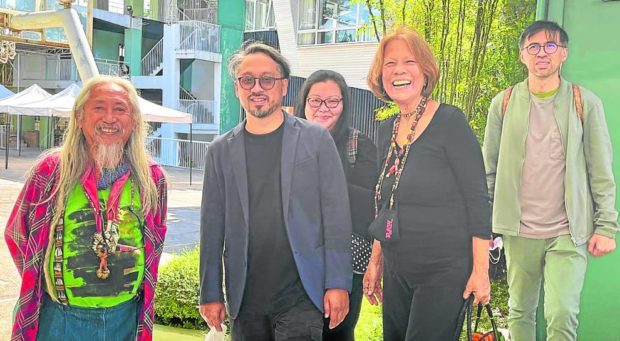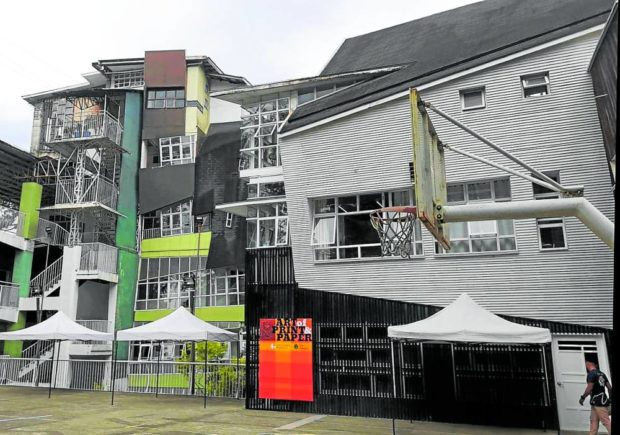
ART PATRONS Aris Go (extreme right) with National Artist Kidlat Tahimik (left) and Gallery Ninety partners Berg Go, Marbee Go and Mara Pardo de Tavera —Contributed photo
BAGUIO CITY—Alluring and surreal art pieces made by one of the pioneers of Philippine printmaking, Virgilio “Pandy” Aviado now hang at Gallery Ninety in this city.
One of Aviado’s eye-catching prints on display has an unusual collection of images, like a screw aimed at a bleeding hand with no fingers, and what should be a horse but with a lightbulb for a tail and a fishbowl stomach. At the top of the page is the letterhead, “Malacañang, Manila.”
Aviado is celebrated for pushing the envelope in his decades-old body of work, and his art feels very much at home in a gallery put up inside what is arguably the most outlandishly-designed school in Baguio City.
Gallery Ninety is at the courtyard of Berkeley School, a building which is immediately visible from afar because of its crooked windows and off-tangent facade. This nonprofit K-12 private school, established in 2002 and owned by the family of Baguio Rep. Marquez Go, was designed by son, Aris Go, when he was at his “most playful.”
Aris—a prolific Baguio architect, and his former University of the Philippines classmate and sister-in-law Marbie, a journalist—conceived the gallery back in college.
This is phase one of the duo’s plan to build a full-blown “Creative Space” in the summer capital-the country’s first city to join the world’s creative cities network of the United Nations Educational, Scientific and Cultural Organization in 2017, Aris says.
“Iyong mga passion namin for art design and architecture, gusto naming i-express rito. Matagal na namin itong pinag-uusapan ni Marbie. Dito sa Baguio, noong time na iyon, walang galleries, so ginusto naming magtayo ng gallery (We wanted to express our passion for art design and architecture in this gallery. Marbie, an arts studies major, and I have discussed it for a long time. During that time here in Baguio, there were no commercial galleries, which was why we wanted to put one up),” he tells the Inquirer in an interview.
The art space project is unique because Berkeley is part of the process, Aris adds.
‘Huge risk’
He says the family had wanted to incorporate creativity into Berkeley’s curriculum for elementary and high school, given that Aris’ architectural and design office is situated there.
Interested high school students have been taken in as interns so they can immerse themselves in design, engineering and architectural work.
But investing in Gallery Ninety during a pandemic is a “huge risk” since COVID-19 has not been kind to Baguio artists, craftsmen and performers, Marbie acknowledges.
As many as 600 Baguio “creatives” were displaced or lost potential income due to the quarantines and hard lockdowns, says University of the Philippines Baguio professor Raymundo Rovillos, co-chair of the Creative Baguio City Council and president of the Baguio Arts and Crafts Collective Inc.
The city’s creative economy is composed of micro and small enterprises, nonprofit groups and independent professional artists that operate in the fringes.
According to him, Gallery Ninety started out as a pop-up gallery but is now a paying gallery and its revenues will make his creative space project sustainable.
Opportunity
The pandemic gave Aris and Marbie the opportunity to fulfill their vision. Because there were no students, they were able to repurpose classrooms for art or science laboratories, or to incubate creative art spaces for children that are being introduced by innovative educators like Vivita Philippines, Aris says.
Berkeley had been prepared for online and distance learning becoming the norm during the lockdowns. Aris and his team introduced an online learning management system back in 2006, which Berkley intends to continue as part of a blended learning program when the pandemic ends.
“All lectures will become online and then, most of the physical, collaborative activities will be done in school,” Aris says. If half of the children are online and half in classrooms, he says Berkeley could maximize school space for carpentry work or 3-D printing shops.
“We are convinced that online learning has been very effective compared to traditional lectures … If students do not understand a lesson, they can rewind the recorded video and watch it all over again at their own pace,” he says. INQ


